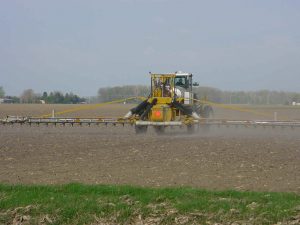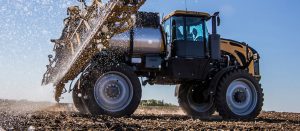Agronomy, Homepage Slider, Precision Technology
Using Technology to Reduce Off-Target Pesticide Movement
By Dusty Sonnenberg, CCA, Ohio Field Leader, a project of the Ohio Soybean Council and soybean check-off.
One of the primary goals of a spray applicator is to get the product on the target. While this sounds relatively simple, there are a number of factors that come into play. Environmental conditions such as wind, temperature, and humidity all play a role. Physical conditions from the application equipment can also have an impact on the efficiency and effectiveness of the application. Turbulence can be caused by the spray equipment.
Turbulence is caused by the movement of the boom and tires in field crop spraying. The faster the ground speed of the sprayer, the greater the turbulence behind the sprayer, and the greater likelihood of having an off-target (spray drift) situation. One solution to reduce the turbulence concern is to spray at a slower ground speed. Another solution is to use an air blast sprayer. With an air blast sprayer, the ground speed can be higher because spray droplets are unimpeded by turbulence caused by the sprayer chassis and instead are directed toward the target by forced air.
The spray droplet size can be a critical factor in pesticide off-target movement. Pesticide application rates have three variables, which include: ground speed, spray boom pressure, and the spray nozzle orifice size. In a basic spray application, the nozzle is rated at a gallons per acre rate at a given pressure. The spray application rate can be adjusted by changing the pressure and or ground speed. By increasing the pressure, a given nozzle will produce more droplets that are smaller in diameter. By maintaining the pressure, the droplet size will remain constant. With automatic rate controllers, the pressure is typically adjusted and increased when ground speed increases to allow for the same volume of spray to cover the acreage being covered. This changes the droplet size.
Research has been conducted to determine the best droplet size to reduce the risk of drift under given conditions. Droplets the size of 50 microns in diameter or less are very likely to drift and be completely evaporated before they reach a point 18” below the spray tip. According to research conducted by The Ohio State University, most nozzles used for applying pesticides produce a large portion of the spray volume in 100 micron diameter droplets and larger. The greater the diameter of the spray droplet, the less chance of drift or movement off-target.
The development and use of pulse width modulation (PWM) technology allows for a consistent droplet size to be applied, regardless of changes in ground speed and boom pressure. To understand how a PWM valve tip functions, it can be visualized like an old camera that adjusts the shutter speed (which dictates how long the shutter stays open) based on the amount of light required to get the exposure desired. The size of the PWM valve opening is fixed, but the length of time the valve is open will change (modulate) and pulsate. The “duty cycle” of the open time allows the pressure to be held constant going into the nozzle and thus the droplet size coming out of the tip will remain the same. Unlike a spray rate controller that simply adjusts pressure to the boom based on the ground speed, the PWM valve allows each nozzle to maintain the pressure going into the spray tip regardless of changes in ground speed or turns. Many companies have made announcements in this area of new products, such as the Ag Leader® RightSpot ™ and Precision Planting® Symphony Nozzle Control System.